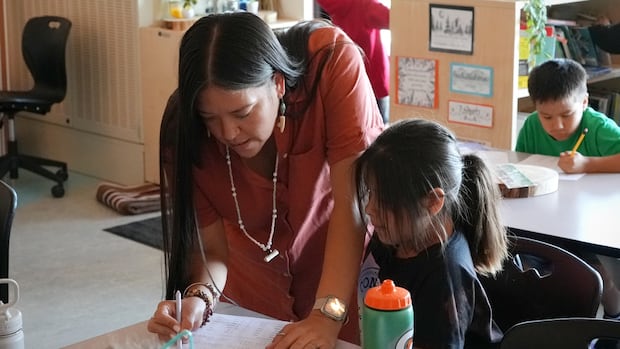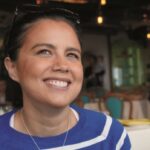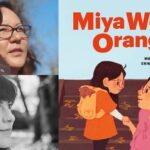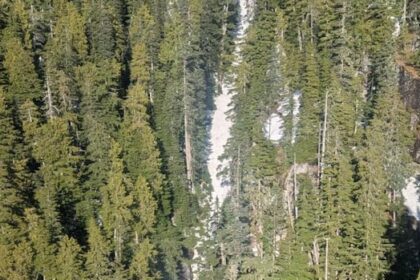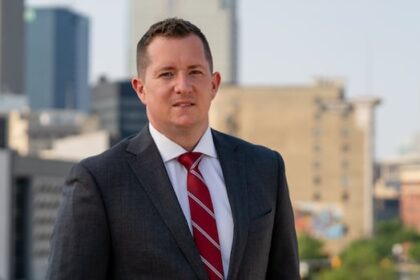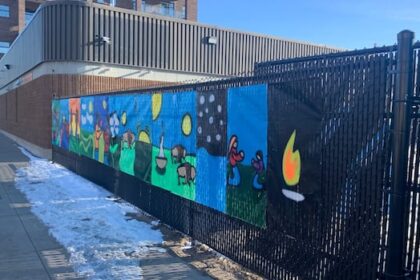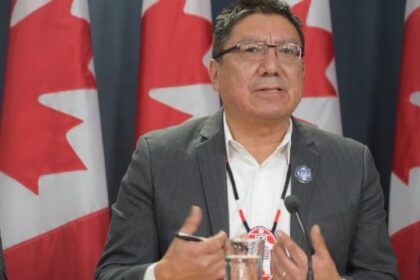Modelled after the whitecaps on Okanagan Lake and built on traditional Syilx land using teachings passed down since time immemorial, the new Nk̓maplqs Iʔ Snm̓am̓ay̓aʔtn Iʔ K̓l Sqilxʷtət Indigenous cultural immersion school in Vernon, B.C., has opened its doors to all.There, students from kindergarten to Grade 7 are learning to speak and sing the Okanagan language that, for many, their parents never got to learn and their grandparents had to whisper in secrecy. “This school really represents a different era,” said Okanagan Indian Band Chief Dan Wilson, standing in front of the new building.The school name Nk̓maplqs iʔ snm̓am̓ay̓aʔtn iʔ k̓l sqilxʷtət means “North Okanagan, head of the lake, place where our children learn our Syilx ways.”It’s a place where students learn B.C.’s education curriculum through an Indigenous lens, with hands-on experiences, language, movement and land-based learning as guiding principals.Okanagan Indian Band Chief Dan Wilson has been taught that learning language is the only way to truly understand a culture. (Matisse Harvey/CBC)The new school was unveiled at the start of the school year and features 12 classrooms, a gymnasium, a library, cultural spaces, a cafeteria and outdoor areas for learning in nature.The new building replaces the drafty portable classrooms and old Indigenous day school building that students had been learning in since 2006. Its construction was funded by $2.85 million from the band and $19.3 million from the federal government. The new building for the cultural Immersion school in Vernon, B.C., called Nk̓maplqs Iʔ Snm̓am̓ay̓aʔtn Iʔ K̓l Sqilxʷtət is modelled after the waves on Okanagan Lake. (Matisse Harvey/CBC)Learning language to understand truthChief Wilson said he is a product of the residential school system, where his parents and grandparents were forbidden from speaking their language.”They weren’t allowed to speak their language. The punishments were severe.”His mother and aunt, who used to whisper to each other in their language at night at residential school, have cried tears of joy watching students sing in Indigenous languages that were not long ago forbidden in school. “For them to experience that in their lifetime was really something to see.”To truly understand a culture and its history, you must understand the language, Wilson said.”Elders tell us that our laws and our worldview is embedded in our language.”WATCH | Knowledge keepers says truth comes before reconciliation: Westbank First Nation elder offers advice on how to integrate reconciliationWestbank knowledge keeper Pamela Barnes, who teaches a course in cultural competency from a Syilx perspective, provides insights on how organizations and individuals can integrate reconciliation into their workplaces and lives.Today, Wilson’s grandchildren attend Nk̓maplqs Iʔ Snm̓am̓ay̓aʔtn Iʔ K̓l Sqilxʷtət and speak nsyilxcən better than he ever could.At the immersive school, students learn Syilx creation stories called captikʷł, and spend more than an hour every day practising nsyilxcən, the Okanagan language, that is also woven into all lessons.A photo of students attending the Okanagan Day School at Six Mile Creek in what is now known as Vernon, B.C. The school was built in 1923 and is now used as a cultural centre. (Submitted by Okanagan Indian Band)Before reconciliation, there must be truthWilson said many elders in his community find the term reconciliation on its own to be controversial, especially when it is not paired with action.”There has to be truth before there’s reconciliation,” he said. He said parts of Canada’s colonial history involving reserves, residential schools, treaties, access to the land and broken promises, have yet to be recognized or talked about.He said teaching students from all backgrounds the Okanagan culture, history and language is a step toward reconciliation.A poster in a classroom at the nk̓maplqs iʔ snm̓am̓ay̓ʔtn iʔ k̓l sqilxʷtət cultural immersion school in Vernon, B.C., that uses Syilx cultural teachings to help students understand how to behave while doing partner work in class. (Matisse Harvey/CBC)The circle of education benefits all people “The first thing about reconciling is learning the truth, and that is what they’re teaching here,” said Sarah Dudar, a mother of two children who attend Nk̓maplqs Iʔ Snm̓am̓ay̓aʔtn Iʔ K̓l Sqilxʷtət. Syilx Okanagan culture is woven into every lesson and class at nk̓maplqs iʔ snm̓am̓ay̓ʔtn iʔ k̓l sqilxʷtət. (Matisse Harvey/CBC)She is not a band member but feels it is important for children to experience a different way of learning and to understand and appreciate the land they are growing up on. “The way that they get it taught is just a beautiful, simple way for a child to learn it.”Dudar said she has loved watching her children blossom in the hands-on, immersive environment. Now, when on hikes, her daughter teaches her about plants and their medicinal purposes, and she can play a hand drum and speak and sing in nsyilxcən. Sarah Dudar says she wanted her kids to attend nk̓maplqs iʔ snm̓am̓ay̓ʔtn iʔ k̓l sqilxʷtət to partake in a different way of learning. (Matisse Harvey/CBC)The immersion school is largely attended by the children of Okanagan Indian Band members, who never got the opportunity to learn their language or traditions.”Unfortunately, when I grew up, I didn’t have the opportunity to learn, so my children have actually taught me a lot of things,” said Miranda Marchand, a mother of five who works as the manager of the early childhood education centre. Her children have all attended or are currently attending the school.The new nk̓maplqs iʔ snm̓am̓ay̓ʔtn iʔ k̓l sqilxʷtət school building features a circular room that was designed for drumming. (Matisse Harvey/CBC)With tears of pride in her eyes she said her children are proud of their ability and choice to speak nsyilxcən outside of school.”Sometimes they’ll have some side conversations among themselves that I fully don’t understand,” Marchand said.Her son Owen said he has been teaching his mother the names of places, foods, appliances and numbers. “She’ll ask us what something is and then we have to tell her because she doesn’t know a lot of it. Like, we are pretty good at [speaking] Okanagan,” Owen said.Marchand’s older children who are now in high school still come back to visit the elementary school and help teach drumming when they can. She said seeing her children feel pride about their culture and language makes her emotional. “I didn’t have that opportunity to come through a school to be able to learn my roots and my background and my cultural identity. Having that opportunity for my children is amazing.”Curriculum through an Indigenous lens Teacher Alicia Marchand, who is known as Tum in the classroom and community, creates all of her own teaching resources.Her classroom is decorated with hand-made posters, photographs of her childhood and community elders, and cutouts of the alphabet and numbers in nsyilxcən.Miranda Marchand says she never had the opportunity to learn her language or culture, and now her children teach her. (Matisse Harvey/CBC)She adapts and moulds the provincial curriculum to the needs of her class and to the seasons.Tum weaves the nsyilxcən language and Syilx teachings into all subjects, from math to social sciences. In the fall, her students learn how to preserve the berries they picked in the summer to last the winter. They draw rainbow trout in art class and learn about biodiversity by being outside and harvesting cattails along the water’s edge.Tum said in the new building, students are more connected to nature and to each other. Because the classrooms are all in one building, and not spread out as portables, there is more opportunity for the students to come together and learn.”Being able to make new memories here and just be able just to look outside and just touch our ancestral homelands is an amazing feeling,” she said.In the old space Tum said she “wasn’t complete” and often felt that “the energy just wasn’t safe.”But with the new building, that has changed.”Here, I feel like I’m complete,” she said.
Okanagan Indian Band opens new cultural school
